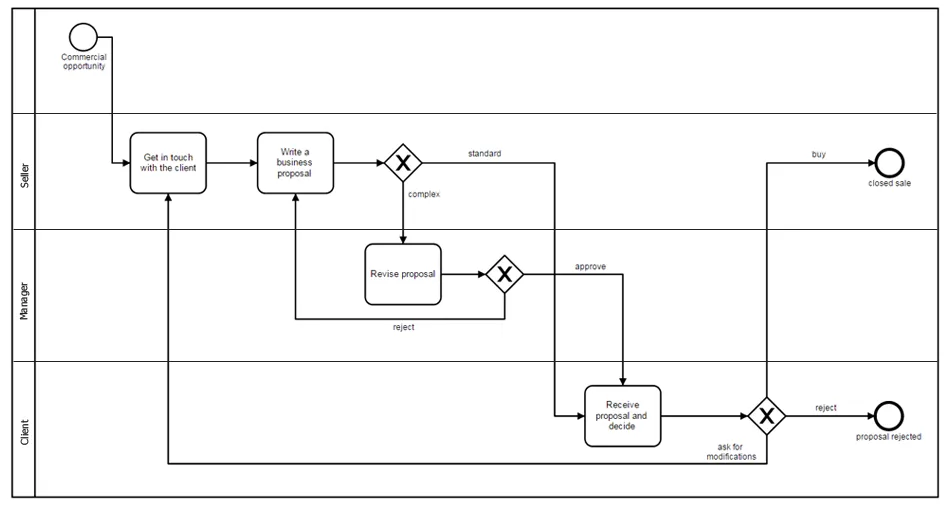Why Selling is Essential for SMEs
Blog: BPM Leader
To survive, every business needs to generate profits, which ultimately means selling.
Companies that are established and have a larger infrastructure can overcome difficult times or decide to focus on areas other than sales. But for Small and Medium Enterprises (SMEs) just starting out, selling is essential. At this early stage of development, the only way to grow is by selling, but often CEOs and managers are not aware of this.
This article won’t cover the sale of goods, which tend to have a short sales cycle. Instead, we will focus on SMEs that work with long sales cycles, typically consultative sales that require customer relationships and several interactions before closing the sale.
Such sales are very important because they generate long-term relationships with customers. We can model these sales as a process in which different members of the SME participate during different stages of the sales process.
In a previous post we explained why it is important for an SME to manage their business processes. It is essential to identify the stages of the selling process to maximize the amount of sales and thus make the SME succeed.
While there may be as many processes types as businesses, we decided to highlight three common sales process that support consultative sales. Automate, measure and improve these processes. It’s the only methodical way to maximize the chance of success of SMEs.
1. Identifying potential sales
Identify interesting scenarios that could lead to a sale. For example, an encounter with an acquaintance who expresses a need, a call from an interested person, an email requesting additional information. It is not a business opportunity yet. It needs to go through several steps to become one. Ideally you should have a process where you register all these initiatives and provide follow-up with these steps: Identify the potential sale: establish contact with the interested part and register the initiative with its main details (contact information, potential customer, etc.)
Identify the potential sale: establish contact with the interested part and register the initiative with its main details (contact information, potential customer, etc.)
- Evaluate the initiative: Is it an opportunity? Check if the customer has a budget and identify the decision maker. This step may require several interactions.
- Initiative became an opportunity: If the evaluation was positive, it became opportunity. The initiative as such ends.
- Initiative rejected: If the evaluation was negative, it did not become an opportunity. The initiative as such ends.
2. Commercial opportunities

This process may begin in two ways: an initiative that became an opportunity (as a continuation of the previous process) or a specific need of a customer. Next step: a qualified seller writes a business proposal based on the customer’s needs.
There are standard proposals, which go directly to the customer (e.g. via email) and there are others that are more complex and require approval from the manager or supervisor. To simplify things, let’s say that the client can only do three things: buy, reject the proposal or request modifications.
All these steps are shown in the previous workflow. Analyzing the steps has major advantages:
- You can see which proposals are recent, contact those customers who we sent the proposal to but never got an answer (typical problem of SMEs: sending a proposal and never ask the client about it).
- It is possible to make a sales forecast based on the quoted projects. We can anticipate operational, stock, financial requirements, etc., all fundamental aspects for an SME with limited resources.
- Build a sales team that is coordinated, properly distribute clients and amount of work.
3. Closing the sale
Once the opportunity is recognized, the sale has to be closed. It is important to ensure customer satisfaction to lay the foundations for a long-term relationship. The closing of the sale is supported by the following steps:
- Arrange sale details: define the terms of the sale, set the deadlines, delivery method, etc.
- Delivery: this step should not be considered finished until the product/service is charged, because that is the true indicator of customer satisfaction.
- Evaluate the sale: this step is often overlooked, but it is extremely important. The seller meets with the client, assesses the project / service, hears objections, and lays the foundation for future work. New opportunities may arise from this meeting.
- Sale satisfactory completed: the customer is satisfied. The project / service is considered closed.
- Sale completed with objections: define a plan to improve those objections. The project / service is considered closed.
What’s next: improve the selling process
After reading this article, some might think that selling is intuitive and you learn it on the go. That is somewhat true, but it is also important to improve the efficiency of the selling process. Faster sales manage resources better and improve customer satisfaction. This is essential for the development of an SME that offers consultative sells. Generate long-term relationship to reduce the cost of future commercial transactions.
Defining the processes involved in a sale helps improve efficiency. To simplify this task, you can use a BPM tool.
Finally, a great advantage of automating processes is the ability to objectively measure the results. That way it is easier to evaluate your work and the work of your team in your SME. For example, possible indicators of the three mentioned processes are:
- Number of initiatives obtained to measure how much interest generates our product / service.
- Number of opportunities that became a sale to analyze if we are closing sales effectively.
- Number of projects successfully completed to see if we are running our business well and generating the desired long-term relationships with our customers.
The post Why Selling is Essential for SMEs appeared first on BPM Leader.